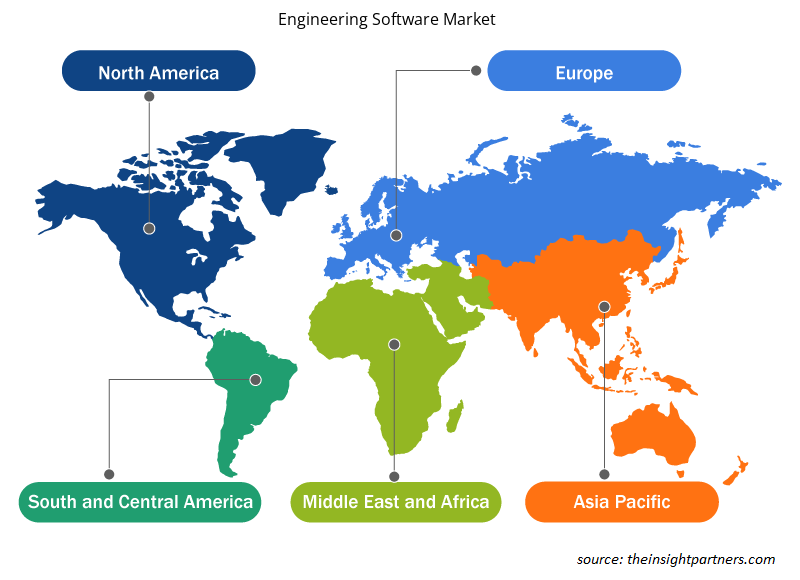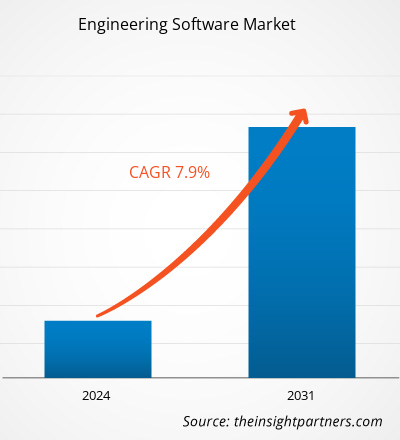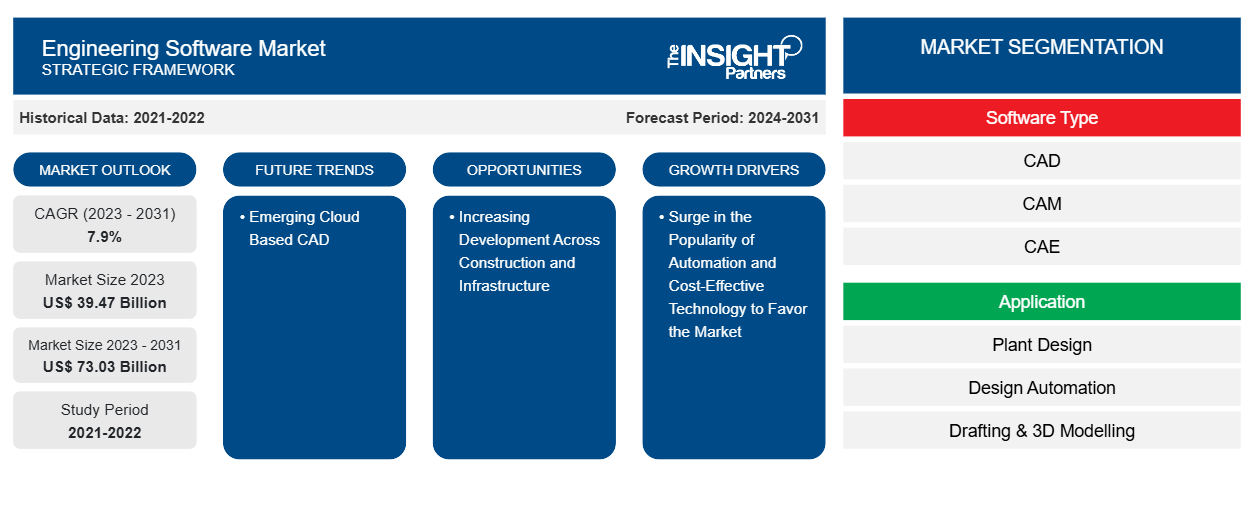من المتوقع أن يصل حجم سوق البرمجيات الهندسية إلى 73.03 مليار دولار أمريكي بحلول عام 2031 من 39.47 مليار دولار أمريكي في عام 2023. ومن المتوقع أن يسجل السوق معدل نمو سنوي مركب بنسبة 7.9٪ في الفترة من 2023 إلى 2031. ومن المرجح أن يظل الارتفاع في شعبية الأتمتة والتكنولوجيا الفعالة من حيث التكلفة من الاتجاهات الرئيسية لسوق البرمجيات الهندسية.
تحليل سوق البرمجيات الهندسية
إن الاستخدام المتزايد لبرامج التصميم بمساعدة الحاسوب (CAD) والتصميم بمساعدة الحاسوب (CAE) في مجموعة من الصناعات، بما في ذلك قطاعات السيارات والفضاء والبناء والرعاية الصحية، هو المسؤول عن توسع السوق. تشمل برامج الهندسة، من بين أمور أخرى، التصميم بمساعدة الحاسوب (CAD)، والتصنيع بمساعدة الحاسوب (CAM)، والهندسة بمساعدة الحاسوب (CAE). ومن المتوقع أن يتوسع سوق برامج الهندسة بشكل كبير طوال فترة التنبؤ لعدة أسباب، بما في ذلك الطلب المتزايد على الشركات لتقصير الوقت ونفقات تطوير المنتجات.
نظرة عامة على سوق البرمجيات الهندسية
يمكن للمهندسين والمصممين والمصنعين كتابة وثائق هندسية بالغة الأهمية، وتحليل ومحاكاة أداء المنتج وعملياته، وتطوير نماذج معقدة بمساعدة حلول برمجيات الهندسة. مع الحلول المستندة إلى السحابة، يمكن لأعضاء الفريق التعاون عن بُعد باستخدام أي جهاز يختارونه لأنه يمكن الوصول إليه من خلال متصفح الويب. ونتيجة لذلك، يمكن للشركات تحديث وتقليل نفقات الأجهزة دون التضحية بالقوة الحسابية أو الفائدة.
قم بتخصيص هذا التقرير ليناسب متطلباتك
ستحصل على تخصيص لأي تقرير - مجانًا - بما في ذلك أجزاء من هذا التقرير، أو تحليل على مستوى الدولة، وحزمة بيانات Excel، بالإضافة إلى الاستفادة من العروض والخصومات الرائعة للشركات الناشئة والجامعات
-
احصل على أهم اتجاهات السوق الرئيسية لهذا التقرير.ستتضمن هذه العينة المجانية تحليلاً للبيانات، بدءًا من اتجاهات السوق وحتى التقديرات والتوقعات.
محركات وفرص سوق البرمجيات الهندسية
ارتفاع شعبية الأتمتة والتكنولوجيا الفعالة من حيث التكلفة لصالح السوق.
تتعرض شركات الهندسة والتوريد والبناء في جميع أنحاء العالم لضغوط لتقليل أخطاء الإنتاج والنفقات التشغيلية بسبب المنافسة المتزايدة في السوق. يمكن لمهندسي المصانع تحسين الجودة من خلال اتباع معايير دولية معينة أثناء عمليات التصميم والإنتاج والتشغيل. يمكن حل مشكلات الإنتاج والكثافة باستخدام برامج التصميم والتحليل المستمر والترقيات القياسية. ونتيجة لذلك، تستخدم الشركات في جميع أنحاء العالم برامج الهندسة بشكل متزايد لتقليل الأخطاء في البناء والإنتاج.
زيادة التنمية في مجال البناء والبنية التحتية
يُعتقد أن البناء هو أحد العوامل الرئيسية التي تساهم في التنمية الاجتماعية والاقتصادية لأي بلد. تتوسع صناعة البناء بسرعة في الدول النامية حول العالم، بما في ذلك إثيوبيا والهند والصين والبرازيل وأوزبكستان وكمبوديا وتنزانيا وميانمار. كما تتطور البنية التحتية الأساسية لهذه الاقتصادات بمعدل سريع. على سبيل المثال، تجتذب الاقتصادات النامية في آسيا والمحيط الهادئ وجنوب إفريقيا الكثير من الاستثمار الأجنبي المباشر في تطوير البنية التحتية الخاصة بها. ستحفز هذه التطورات أيضًا نمو بنيتها التحتية، ومع توسع صناعة البناء، ستزداد الحاجة إلى برامج الهندسة. لذلك، من المتوقع أن تقدم التطورات المتزايدة في البنية التحتية وقطاعات الأعمال الإنشائية المزيد من الفرص.
تقرير تحليل تجزئة سوق البرمجيات الهندسية
إن القطاعات الرئيسية التي ساهمت في استخلاص تحليل سوق البرمجيات الهندسية هي نوع البرنامج والتطبيق.
- بناءً على نوع البرنامج، ينقسم سوق برامج الهندسة إلى CAD وCAM وCAE وAEC وEDA. ومن المتوقع أن ينمو قطاع CAD في الفترة المتوقعة.
- من حيث التطبيق، يتم تقسيم السوق إلى تصميم المصانع، وأتمتة التصميم ، والرسم والنمذجة ثلاثية الأبعاد، وتصميم المنتجات واختبارها، وغيرها. ومن المتوقع أن ينمو قطاع أتمتة التصميم في الفترة المتوقعة.
تحليل حصة سوق البرمجيات الهندسية حسب المنطقة الجغرافية
ينقسم النطاق الجغرافي لتقرير سوق برمجيات الهندسة بشكل أساسي إلى خمس مناطق: أمريكا الشمالية، ومنطقة آسيا والمحيط الهادئ، وأوروبا، والشرق الأوسط وأفريقيا، وأمريكا الجنوبية/أمريكا الجنوبية والوسطى. سيطرت أمريكا الشمالية على سوق برمجيات الهندسة. وقد أدت اتجاهات تبني التكنولوجيا العالية في مختلف الصناعات في منطقة أمريكا الشمالية إلى تغذية نمو سوق برمجيات الهندسة. ومن المتوقع أن تؤدي عوامل مثل زيادة تبني الأدوات الرقمية والإنفاق التكنولوجي المرتفع من قبل الوكالات الحكومية إلى دفع نمو سوق برمجيات الهندسة في أمريكا الشمالية. علاوة على ذلك، فإن التركيز القوي على البحث والتطوير في الاقتصادات المتقدمة في الولايات المتحدة وكندا يجبر اللاعبين في أمريكا الشمالية على جلب حلول متقدمة تقنيًا إلى السوق. بالإضافة إلى ذلك، يوجد في الولايات المتحدة عدد كبير من اللاعبين في سوق برمجيات الهندسة الذين يركزون بشكل متزايد على تطوير حلول مبتكرة. تساهم كل هذه العوامل في نمو سوق برمجيات الهندسة في المنطقة.
رؤى إقليمية حول سوق البرمجيات الهندسية
لقد قام المحللون في Insight Partners بشرح الاتجاهات والعوامل الإقليمية المؤثرة على سوق برمجيات الهندسة طوال فترة التوقعات بشكل شامل. يناقش هذا القسم أيضًا قطاعات سوق برمجيات الهندسة والجغرافيا في جميع أنحاء أمريكا الشمالية وأوروبا ومنطقة آسيا والمحيط الهادئ والشرق الأوسط وأفريقيا وأمريكا الجنوبية والوسطى.

- احصل على البيانات الإقليمية المحددة لسوق برمجيات الهندسة
نطاق تقرير سوق برمجيات الهندسة
| سمة التقرير | تفاصيل |
|---|---|
| حجم السوق في عام 2023 | 39.47 مليار دولار أمريكي |
| حجم السوق بحلول عام 2031 | 73.03 مليار دولار أمريكي |
| معدل النمو السنوي المركب العالمي (2023 - 2031) | 7.9% |
| البيانات التاريخية | 2021-2022 |
| فترة التنبؤ | 2024-2031 |
| القطاعات المغطاة |
حسب نوع البرنامج
|
| المناطق والدول المغطاة |
أمريكا الشمالية
|
| قادة السوق وملفات تعريف الشركات الرئيسية |
|
كثافة اللاعبين في سوق البرمجيات الهندسية: فهم تأثيرها على ديناميكيات الأعمال
يشهد سوق البرمجيات الهندسية نموًا سريعًا، مدفوعًا بالطلب المتزايد من المستخدم النهائي بسبب عوامل مثل تفضيلات المستهلك المتطورة والتقدم التكنولوجي والوعي المتزايد بفوائد المنتج. ومع ارتفاع الطلب، تعمل الشركات على توسيع عروضها والابتكار لتلبية احتياجات المستهلكين والاستفادة من الاتجاهات الناشئة، مما يؤدي إلى زيادة نمو السوق.
تشير كثافة اللاعبين في السوق إلى توزيع الشركات أو المؤسسات العاملة في سوق أو صناعة معينة. وهي تشير إلى عدد المنافسين (اللاعبين في السوق) الموجودين في مساحة سوق معينة نسبة إلى حجمها أو قيمتها السوقية الإجمالية.
الشركات الرئيسية العاملة في سوق البرمجيات الهندسية هي:
- بي تي سي
- شركة روكويل للأتمتة
- ساب اس اي
- سيمنز
- شركة سينوبسيس
- شركة أوتوديسك
إخلاء المسؤولية : الشركات المذكورة أعلاه ليست مرتبة بأي ترتيب معين.

- احصل على نظرة عامة على أهم اللاعبين الرئيسيين في سوق برمجيات الهندسة
أخبار سوق البرمجيات الهندسية والتطورات الأخيرة
يتم تقييم سوق برمجيات الهندسة من خلال جمع البيانات النوعية والكمية بعد البحث الأولي والثانوي، والتي تتضمن منشورات الشركات المهمة وبيانات الجمعيات وقواعد البيانات. فيما يلي قائمة بالتطورات في السوق:
- في فبراير 2024، تهدف شركة التكنولوجيا العالمية Cognizant إلى تسريع تحديث الأعمال من خلال توسيع مجموعة عروض المنصات الخاصة بها. أعلنت الشركة عن إطلاق Cognizant Flowsource، وهي منصة توليدية مدعمة بالذكاء الاصطناعي مصممة لتشغيل عصر جديد من هندسة البرمجيات.
(المصدر: Cognizant، بيان صحفي، 2024)
- في يونيو 2023، تم إطلاق Nullspace, Inc. كشركة فرعية من IERUS Technologies، وهي شركة مقاولات دفاعية راسخة في هانتسفيل، ألاباما. تركز Nullspace, Inc. على تقديم برامج هندسية متقدمة لتطبيقات الكهرومغناطيسية.
(المصدر: Nullspace، بيان صحفي، 2023)
تغطية تقرير سوق برمجيات الهندسة والمنتجات النهائية
يوفر تقرير "حجم سوق برمجيات الهندسة والتوقعات (2021-2031)" تحليلاً مفصلاً للسوق يغطي المجالات التالية:
- حجم السوق والتوقعات على المستويات العالمية والإقليمية والوطنية لجميع قطاعات السوق الرئيسية التي يغطيها النطاق
- ديناميكيات السوق مثل المحركات والقيود والفرص الرئيسية
- الاتجاهات المستقبلية الرئيسية
- تحليل مفصل لقوى PEST/Porter الخمس وSWOT
- تحليل السوق العالمي والإقليمي الذي يغطي اتجاهات السوق الرئيسية واللاعبين الرئيسيين واللوائح والتطورات الأخيرة في السوق
- تحليل المشهد الصناعي والمنافسة الذي يغطي تركيز السوق، وتحليل خريطة الحرارة، واللاعبين البارزين، والتطورات الأخيرة
- ملفات تعريف الشركة التفصيلية
- التحليل التاريخي (سنتان)، سنة الأساس، التوقعات (7 سنوات) مع معدل النمو السنوي المركب
- تحليل PEST و SWOT
- حجم السوق والقيمة / الحجم - عالمي، إقليمي، بلد
- الصناعة والمنافسة
- مجموعة بيانات إكسل
التقارير الحديثة
تقارير ذات صلة
شهادات العملاء
سبب الشراء
- اتخاذ قرارات مدروسة
- فهم ديناميكيات السوق
- تحليل المنافسة
- رؤى العملاء
- توقعات السوق
- تخفيف المخاطر
- التخطيط الاستراتيجي
- مبررات الاستثمار
- تحديد الأسواق الناشئة
- تحسين استراتيجيات التسويق
- تعزيز الكفاءة التشغيلية
- مواكبة التوجهات التنظيمية























 احصل على عينة مجانية ل - سوق برمجيات الهندسة
احصل على عينة مجانية ل - سوق برمجيات الهندسة